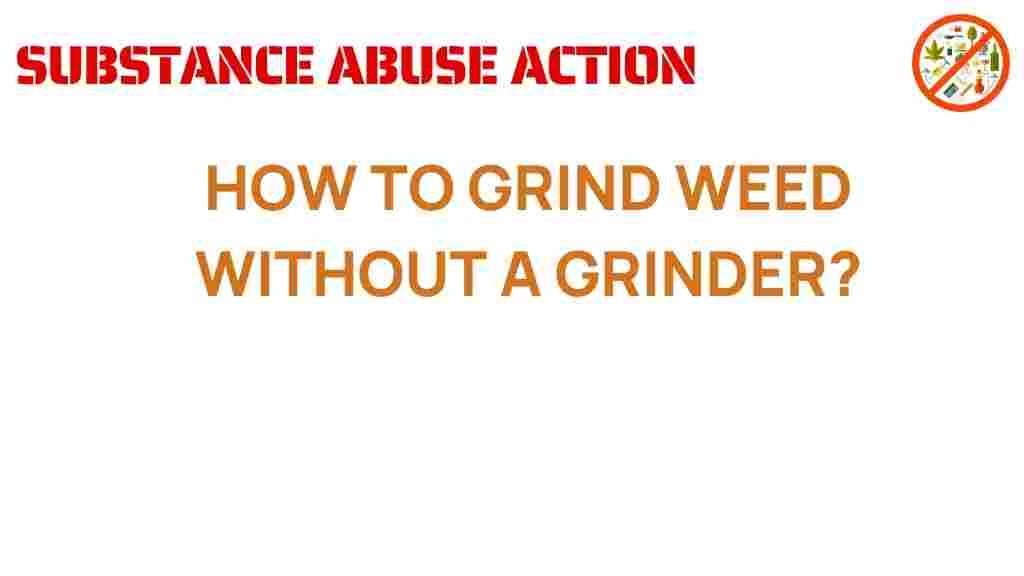Mastering the Art of Grinding Weed Without a Grinder
When it comes to preparing cannabis for smoking, the right grind can make all the difference. While many seasoned users rely on traditional grinders, there are numerous methods to achieve a fine grind without this essential piece of equipment. In this article, we will explore various techniques for weed grinding, delve into cannabis preparation, and discuss the best herbal tools for manual grinding. Whether you’re a DIY cannabis enthusiast or simply looking for alternative methods, this guide will provide you with valuable weed tips and tricks.
Why Grind Cannabis?
Grinding your weed is crucial for a variety of reasons:
- Even Burn: A uniform grind ensures that your cannabis burns evenly, providing a smoother smoking experience.
- Increased Surface Area: Grinding increases the surface area of the buds, allowing for better extraction of cannabinoids and terpenes when smoking or vaporizing.
- Convenience: Smaller pieces are easier to pack into bowls, joints, or blunts.
Now, let’s dive into how to effectively grind weed without a grinder, exploring both common household items and some creative techniques.
Common Household Items for Manual Grinding
Before you start, gather some common household items that can assist you in weed grinding:
- Scissors
- Mortar and pestle
- Knife and cutting board
- Blender or food processor
- Fingers (if necessary)
Step-by-Step Guide to Weed Grinding
Method 1: Using Scissors
One of the simplest methods for grinding weed without a grinder is using a pair of scissors. Here’s how to do it:
- Prepare Your Buds: Break your cannabis into smaller pieces with your fingers. This will make it easier for the scissors to cut.
- Cutting: Place the smaller pieces into a small container (like a shot glass). Use the scissors to chop the cannabis into finer pieces. Keep cutting until you achieve your desired consistency.
- Check Texture: Ensure that the grind is even and suitable for your smoking method.
Method 2: Mortar and Pestle
A mortar and pestle is a traditional method for grinding herbs, and it works well for cannabis too:
- Add Cannabis: Place a small amount of cannabis in the mortar.
- Pound and Grind: Use the pestle to pound the cannabis, then grind it in circular motions until you reach the desired consistency.
- Check Consistency: Make sure to mix occasionally to ensure an even grind.
Method 3: Knife and Cutting Board
If you have a sharp knife and a cutting board, you can easily grind your weed:
- Prepare the Cannabis: Break the buds into smaller pieces and spread them on the cutting board.
- Chop Finely: Use the knife to chop the cannabis finely, using a rocking motion to ensure an even grind.
- Scrape and Repeat: Scrape the ground cannabis to the center and continue chopping until you achieve the desired texture.
Method 4: Blender or Food Processor
If you have a larger quantity of cannabis to grind, a blender or food processor can be very effective:
- Break into Pieces: Break your cannabis into smaller chunks to prevent the blender blades from getting stuck.
- Pulse Gently: Add the chunks to the blender and pulse gently. Avoid over-blending as this can turn your cannabis into powder.
- Check Consistency: Stop periodically to check the consistency and avoid over-processing.
Method 5: Using Your Fingers
In a pinch, you can always use your fingers to break apart the buds:
- Break Apart: Take a nug and use your fingers to break it apart into smaller pieces.
- Rub for Finer Grind: If you want a finer consistency, rub the pieces between your fingers or palms.
- Check Texture: Ensure the grind is suitable for your smoking preference.
Alternative Methods for Cannabis Preparation
In addition to manual grinding, there are some alternative methods for preparing your cannabis:
- Hand Rolling: Some users prefer to hand-roll their joints, which allows for a more personal touch and control over the density of the roll.
- Vaporizing: If you’re using a vaporizer, a coarse grind is often sufficient, so you may not need to grind finely.
- Cooking with Cannabis: For edibles, the grind can vary based on the recipe. Some recipes call for coarsely ground cannabis, while others may require a finer texture.
Troubleshooting Tips for Weed Grinding
Even with the best methods, you might face challenges while grinding your cannabis. Here are some troubleshooting tips:
- Sticky Buds: If your cannabis is too sticky, consider freezing it for a short time to make it easier to handle.
- Uneven Grind: Make sure to mix the cannabis well while grinding to achieve a uniform consistency.
- Too Fine or Powdered: If you accidentally grind your cannabis too finely, consider mixing it with some coarsely ground material to achieve the desired texture.
DIY Cannabis Accessories
For those who enjoy DIY projects, creating your own smoke accessories can be a rewarding experience. Here are some ideas:
- Homemade Rolling Papers: Use thin paper or leaves to create your own rolling papers.
- DIY Bongs: You can create a makeshift bong using household items like bottles and tubing.
- Custom Ashtrays: Personalize your smoking experience with unique, homemade ashtrays.
Conclusion
Grinding weed may seem like a straightforward task, but mastering the art of weed grinding without a grinder opens up a world of possibilities and techniques. Whether you choose to use scissors, a mortar and pestle, or even your fingers, understanding the importance of cannabis preparation can enhance your smoking experience significantly. Remember to experiment with different methods and find what works best for you. With these weed tips and alternative methods at your disposal, you’ll be well-equipped to enjoy your cannabis in its finest form.
For more information on cannabis preparation and other related topics, check out this helpful guide. If you’re looking for the best smoke accessories to pair with your freshly ground weed, visit this resource for recommendations.
This article is in the category Treatment and created by SubstanceAbuseAction Team
